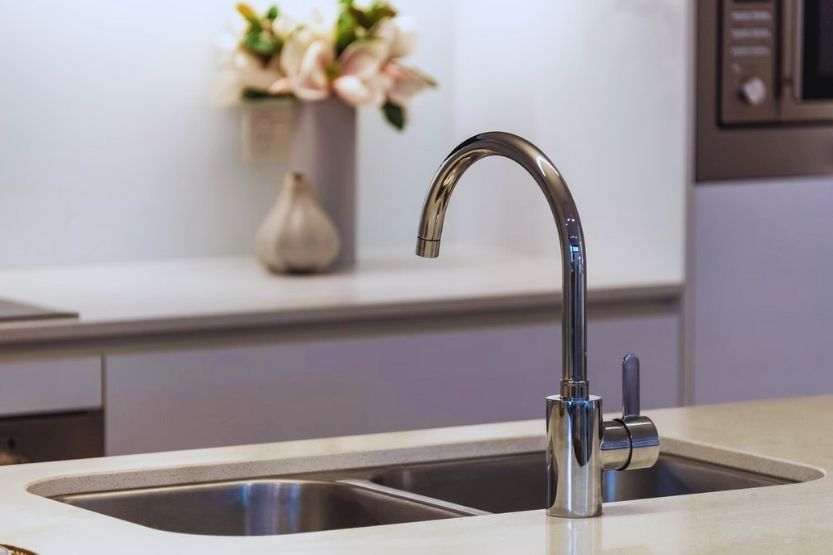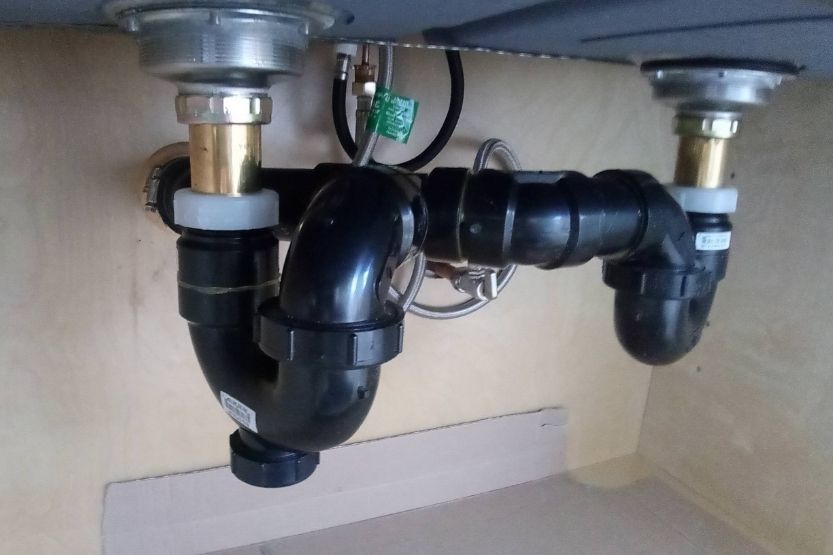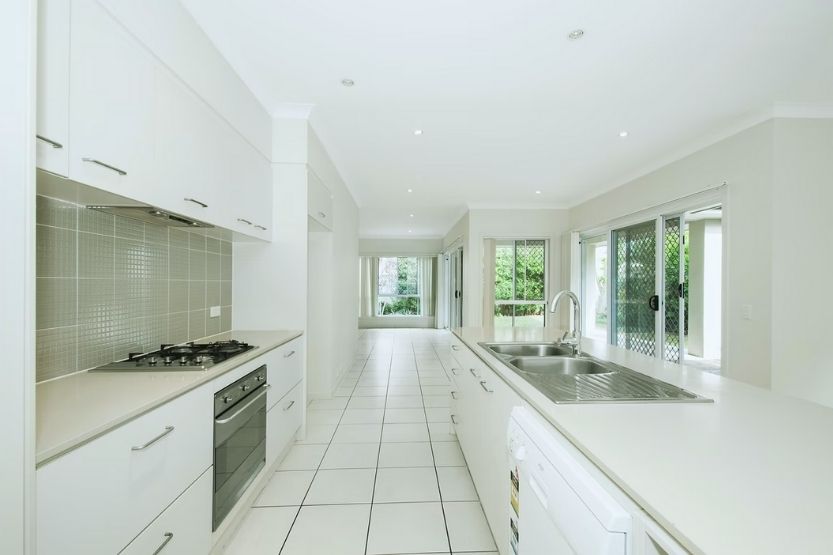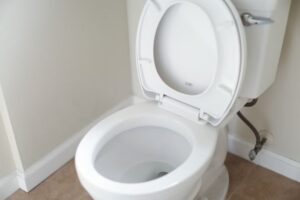Are you thinking of installing a dual basin sink in your bathroom or kitchen? Double sink plumbing is easier than you think. You can even save a lot of money by doing it yourself in your spare time.
Typically, you may be able to adapt the water supply and drain lines to accommodate two sinks. Just use tee fittings, extension hoses, and a couple of simple valves. However, you may need to vent each sink separately depending on what your local plumbing codes require.
Read on to learn more about double sink plumbing, how you can do it yourself, and some tips to make your project foolproof.
About Double Sink Plumbing

Two Sinks Set Side-by-side
As the name implies, a double sink is two sinks set side-by-side on a single countertop. Some sinks already come with two tubs that are easier to install. The reason is that you will only need to cut one big hole in the counter. However, if you want, you can also install two single tub sinks.
Great for Couples or Families
Double sinks are great for couples or families who need to scramble every morning to get ready. Having two sinks means you don’t need to wait in line to brush your teeth or do your hair. You can complete any other things you need to do during your morning routines with this sink.
Make Tasks A Lot Easier to Fulfill
Double kitchen sinks, on the other hand, make kitchen tasks a whole lot easier to fulfill. For instance, washing the dishes will be less of a chore when using two sinks. The main reason is that you have a lot of space to work with. Moreover, you can hang a drying rack over one sink to dry your dishes while having another one ready to use.
Install One Water and Drain Line for Both Sink
If you’re unfamiliar with plumbing, note that both sinks’ separate water supply lines and drain lines are unnecessary. You can easily install the plumbing for both sinks using just one water and drain line.
It’s possible unless you want to position the sinks unusually far from each other. The reason is that this move is inefficient and will only work if you have a large bathroom.
How to Install Double Sink Plumbing

This section will talk about some directions for installing a double kitchen sink. If you will be installing a sink for the bathroom, the directions would still be the same.
However, you will also be installing T-joints on the hot and cold-water outlets to supply separate faucets. If you want to be sure, check out double sink plumbing diagrams to see what they should look like:
1. Turn Off the Main Water Supply
Turn off the main water supply of your home. You can often find it in your basement or crawl space at the side of your house.
2. Locate the Supply Line
Locate the supply line underneath the sink. These are the pipes that will provide water for the faucet.
3. Install Shutoff Valves on the Hot and Cold-water Supply Line Stubs
Install shutoff valves on the hot and cold-water supply line stubs if no valves are installed yet. Place compression nuts and ferrules on each supply line stub. Wrap a good amount of Teflon tape over the threads of the shutoff valve.
After that, screw the compression nut onto it. Tighten it using a crescent until it is hand-tight. Be careful that you don’t crimp the copper tubes when installing the valve.
4. Measure the Distance Between the Shutoff Valves
Measure the distance between the shutoff valves to their respective faucets.
5. Install the Correct Length of Flexible Tubing
Install the correct length of flexible tubing from the shutoff valve to the faucets. Wrap enough Teflon tape over the threads before screwing the connectors together. Remember that the left faucet is for the hot water.
6. Purchase Materials
Unlike plumbing for the faucets, the drain can share one drain pipe. This means you don’t have to install another connection for the other sink.
Purchase PVC piping, including T-connector, P trap, and J waste pipe. You also need two tailpipes and J-tail pipes and seven each of slip nuts and washers.
7. Measure and Cut the Drain Tailpipes
Carefully measure and cut the drain tailpipes to the correct length using a fine-tooth hacksaw. The drain tail should extend a couple of inches from the bottom of the sinks. On some double-sink setups, one basin is deeper than the other.
In this case, you should cut the drain tailpipe for the shallower one longer. You need to have the two ends of the tailpieces at the same level below the sinks.
8. Slip a Nut Over Each Tailpiece End
Slip a nut over each tailpiece end, followed by a washer. The washer needs to fit snug around the end of the pipe to prevent the nut from falling.
9. Measure and Cut J Tailpipes
Carefully measure and cut the two J tailpipes to the correct length. Remember that you will be using a T-connector to join the J pipes. Consider that when measuring. Slip the nuts and washers on the straight tail ends.
10. Connect the T-connector on the Tailpipes
Connect the T-connector on the tailpipes using the slip nuts and washers you placed on the J pipes. Tighten until they are hand-tight.
11. Thread a Nut and a Washer on the Bottom of the T-connector
Thread a nut and then a washer on the bottom of the T-connector. Connect the T-connector on the P-trap using the nuts and washers. Hand-tighten the nuts together.
12. Place a Slip Nut and Washer Over the P-trap’s End
Place a slip nut and washer over the end of the P-trap. Then, attach the J drain pipe to the P-trap using the slip nuts. Make sure that you tighten the nuts firmly.
13. Connect the J Drain Waste Pipe End to the Main Wastewater Pipe
Connect the J drain waste pipe end to the main wastewater pipe using a slip nut and washer—hand-tighten the slip nut to ensure a watertight seal.
14. Fasten All the Slip Nuts Tightly
Fasten all the slip nuts tightly. Also, ensure that all the fittings are firm and secured.
15. Turn on the Water Main
Turn on the water main and check the connections for leaks. Tighten the connections whenever necessary. Do not overtighten the connections.
Again, how to install double sink plumbing? You can use one water supply and drain line for a double sink. To do this, you’ll need tee fittings, extension hoses, and a couple of simple valves. Depending on your local plumbing requirement, you may have to vent the sinks separately.
Which Is Better – Single or Double Sink?
Before the advent of the automatic dishwasher, most homes had the double-bowl, also called a divided sink. Having two basins made it easier to handwash dishes. One basin contains soapy water, and the other sink is for rinsing.
However, now that automatic dishwashers are available in most homes are there still benefits to a double kitchen sink?
What Is a Single-bowl Kitchen Sink?
This is a single sink that has one, typically large, basin. These kinds of sinks are more popular now in most modern homes, especially those with automatic dishwashers.
Most of the time, you can use the kitchen sink for food preparation. Some examples are washing vegetables or draining pasta and other kinds of food preparation.
Pros
Fit Better in Smaller Living Spaces
Settling on a single sink setup is better than double sink designs if you don’t have that much counter space.
More Space for Pots and Pans
Ironically, single bowl sinks have more space for washing large items like pots, baking pans, woks, and others – Double sinks may have two basins, but each bowl is not as big as a single sink design.
Cons
1. You Only Have One Sink to Work With
For instance, if you’re preparing your family’s Thanksgiving meal, you will find that working with a single sink is difficult. When you’re waiting for the pasta to drain, you cannot rinse the vegetables for the salad.
2. Challenging to Wash the Sink
Handwashing in a single bowl sink can be challenging if you must handwash the dishes, like fragile vintage China.
3. Not Garbage Disposal-friendly
If your sink is full of dirty dishes, you will realize that you don’t have access to the garbage disposal. This will not be a problem if you have a double sink. One is for the disposal while the other is for the dishes.
What Is A Double-bowl Kitchen Sink?

A double bowl is also called divided; the kitchen sink has two basins. It comes with a divider that usually separates the basins. Traditionally, both basins were the same size. These are generally used for hand washing the dishes. One sink is for the hot soapy water, while the other is for rinsing the dishes.
These days though, most double-bowl sinks feature one basin significantly smaller than the other. Sometimes, the smaller basin is just half the size of the other. Also, the smaller basin would be shallower than the bigger one. Modern double-bowl kitchen sinks take up significantly lesser space compared to the traditional designs.
Pros
1. More Convenient for Handwashing Dishes
Yes, some people prefer washing their dishes by hand. Many are also forced to because they don’t have a dishwasher or space in their kitchen. One sink is for soapy hot water and the other for rinsing.
2. Multitasking Kitchen Tasks Is Easier
Having two sinks always available is quite nice if you live in a household with a busy kitchen. You can use one sink for food preparation and the other for washing as you go.
3. Provides Access to the Garbage Disposal
Typically, you install the garbage disposal in the smaller sink. Even if the bigger sink is full of dirty dishes, you can still use the garbage disposal whenever needed.
Cons
1. Takes More Space Than Single Sink Setups
A double sink is much bigger than a single sink. This means it will be taking up a lot of counter space. If you don’t have much counter space to spare, avoid getting a double bowl kitchen sink.
2. Losing Out on More Storage Space Under the Counter
Avoid using the storage space under kitchen sinks for anything else other than toxic substances. This is to avoid even more money if you install a double bowl sink. Moreover, garbage disposal takes an insane amount of space, so you cannot put anything in there.
3. Not Enough Space for Washing Large Items
It is quite ironic that you will not be able to wash large items. These include pots, baking pans, woks, and other things that won’t fit your dishwasher. Most double sinks have significantly shallow basins compared to most single sink setups. It is the divider that takes up a lot of space that should have gone to the sinks.
Conclusion – Double Sink Plumbing – Tips and How-To
Installing double sink plumbing is not as complicated as it seems. You can adapt the water and drain lines to accommodate two sinks. You need to get the right T fittings, extension hoses, P traps, and valves. However, you may need to vent each sink separately, depending on your area’s local plumbing codes.
A double sink has its share of advantages and disadvantages. You may need to consider your needs if you are planning on installing them in your kitchen. On the other hand, if you regret getting one, you learned how to install a sink.
Related reading:
Kitchen Sink Clogged Past Trap – How to Fix – 6 Steps



![Kerosene Heater for Garage [Tips and Best Heaters] Kerosene Heater for Garage](https://homecarezen.com/wp-content/uploads/2021/10/Kerosene-Heater-for-Garage-150x150.jpg)
![Kerosene Heater for Garage [Best Picks and Tips] Kerosene Heater for Garage](https://homecarezen.com/wp-content/uploads/2021/11/kerosene-heater-for-garage-150x150.jpg)




